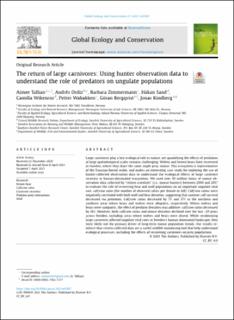The return of large carnivores: Using hunter observation data to understand the role of predators on ungulate populations
Tallian, Aimee Grace; Ordiz Fernandez, Andres Avelino; Zimmermann, Barbara; Sand, Håkan; Wikenros, Camilla; Wabakken, Petter; Bergqvist, Göran; Kindberg, Jonas
Peer reviewed, Journal article
Published version

View/
Date
2021Metadata
Show full item recordCollections
- Publikasjoner fra CRIStin - NINA [2364]
- Scientific publications [1392]
Original version
10.1016/j.gecco.2021.e01587Abstract
Large carnivores play a key ecological role in nature, yet quantifying the effects of predation at large spatiotemporal scales remains challenging. Wolves and brown bears have recovered in Sweden, where they share the same staple prey, moose. This ecosystem is representative of the Eurasian boreal realm, and makes an interesting case study for exploring the use of hunter-collected observation data to understand the ecological effects of large carnivore recovery in human-dominated ecosystems. We used over 50 million hours of moose ob-servation data collected by “citizen scientists” (i.e., moose hunters) between 2000 and 2017 to evaluate the role of recovering bear and wolf populations on an important ungulate vital rate, calf/cow ratio (the number of observed calves per female in fall). Calf/cow ratios were negatively correlated with both wolf and bear densities, suggesting that summer calf survival decreased via predation. Calf/cow ratios decreased by 7% and 17% in the northern and southern areas where bears and wolves were allopatric, respectively. Where wolves and bears were sympatric, the effect of predator densities was additive; calf/cow ratios decreased by 18%. However, both calf/cow ratios and moose densities declined over the last ~20 years across Sweden, including areas where wolves and bears were absent. While recolonizing large carnivores affected ungulate vital rates in Sweden’s human-dominated landscape, they were likely not the primary driver of long-term moose population trends. Our results re-inforce that citizen-collected data are a useful wildlife monitoring tool that help understand ecological processes, including the effects of recovering carnivores on prey populations. Brown bear Calf/cow ratio Carnivore recovery Predator-prey interactions Wolf
